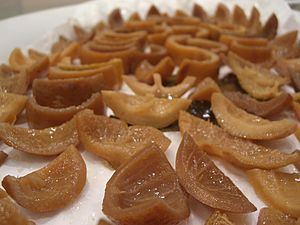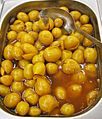Preserved lemon facts for kids

Preserved lemon or lemon pickle is a special ingredient used in cooking, especially in places like India and North Africa. It was also popular in English cuisine a long time ago, in the 1700s.
These lemons are sometimes called "country lemon" or leems. To make them, whole or cut lemons are soaked in a salty water mix called a brine. This brine usually contains water, lemon juice, and salt. Sometimes, spices are added too! The lemons then sit at room temperature for weeks or even months. This process is called pickling or fermenting.
The soft inside part of the preserved lemon can be used in stews and sauces. However, it's the peel (the skin and white part underneath) that people value the most. It has a mild, tangy taste but a very strong lemon flavor.
Contents
What are Preserved Lemons Used For?
Preserved lemons add a unique taste to many dishes. Before using them, you might want to wash them to remove extra salt. You can also quickly boil them to take out even more salt and bring out their natural sweetness. Then, you can slice, chop, or mince them depending on what your recipe needs. You can use the peel by itself or with the soft pulp inside.
Cooking with Preserved Lemons
Preserved lemon is a key ingredient in many Moroccan dishes, like tagines. These are slow-cooked stews often made in a special pot. In Cambodian cuisine, preserved lemons are used in dishes such as ngam nguv, which is a chicken soup.
You'll often find preserved lemons mixed with other ingredients like olives, artichokes, seafood, veal, chicken, and rice. They add a bright, tangy kick to these foods.
Preserved Lemons in Drinks and Sauces
The pickled pulp and liquid from preserved lemons can even be used in drinks like Bloody Marys. They work well in any drink where you'd normally use lemon and salt. The flavor also tastes great with horseradish, like in American-style cocktail sauce.
Traditional Uses of Lemon Pickle
In Ayurvedic cuisine, which is a traditional Indian system of medicine, lemon pickle is used as a home remedy for stomach problems. People believe its healing power gets stronger as it gets older. In some parts of East Africa, lemon pickle is given to help with an enlarged spleen.
How are Preserved Lemons Made?
Making preserved lemons is a traditional way to keep lemons fresh for a long time. This was especially important before refrigerators existed! It allowed people to enjoy lemons long after their growing season and far from where they were grown.
An Old Recipe for Lemon Pickle
Cookbooks from the early 1800s in England and America often had recipes for lemon pickle. They suggested using it in sauces for fish like salmon or meats like veal. Today, we might just use fresh lemon zest or juice for these dishes.
Here's a simple version of an old recipe from a book called A New System of Domestic Cookery:
Choose small lemons with thick skins. Rub them clean. Cut them halfway down into four sections, but don't cut all the way through to the middle. Fill these cuts with salt, pressing it in firmly. Stand the lemons upright in a pan for four or five days until the salt melts. Turn them three times a day in their own liquid until they are soft. Make enough pickle liquid to cover them using vinegar, the lemon's own salty liquid, allspice, and ginger. Boil and skim this liquid. Once it's cold, add it to the lemons with two ounces of mustard seeds and two cloves of garlic for every six lemons. When the lemons are all used, the leftover pickle liquid can be used in fish or other sauces.
– A Lady
Similar recipes appeared in other old cookbooks, showing how popular this method was for preserving lemons. Some recipes even suggested grating or thinly peeling the lemons and drying the peels for later use.
What Happens When Lemons are Preserved?
The process of pickling, or fermentation, causes many changes to the lemons, both inside and out.
Visible Changes to Preserved Lemons
You can see some changes with your eyes. The skin of the lemon will become wrinkled. If you slice the lemon, the inside might turn a little brown because of a process called oxidation, where it reacts with the air.
Chemical Changes During Fermentation
While there isn't a lot of research specifically on lemons, we know that during fermentation, the sugars and starches inside the lemons are broken down. This is why the nutritional value changes. It's also thought that proteins might break down during this process, as they are often absent after fermentation.
Factors Affecting Fermentation
Several things can affect how well lemons ferment and how safe they are to eat. These include the lemon's pH (how acidic it is), its ability to resist changes in pH (buffer capacity), and how much sugar it has to begin with. Larger fruits might have different nutritional values, which can also affect fermentation.
It's also important to be careful about pesticides. If there are a lot of pesticides on the lemon's surface during fermentation, the preservation process can actually make the harmful materials in the pesticides stronger. This is why it's always good to wash fruits well before preserving them.
Why Salt, Acids, and Antioxidants are Important in Preserving
Certain ingredients play key roles in making preserved lemons safe and tasty.
The Role of Salt in Preservation
Salt is a very common ingredient used in curing foods. It makes the liquid very salty, which stops many types of tiny living things (microorganisms) from growing. This creates a difficult environment for bad bacteria to survive, but it allows helpful, salt-tolerant microbes to grow. Salt also helps foods last longer on the shelf.
The Role of Acids in Preservation
Lemon juice is naturally acidic because it contains citric acid. This acid helps to lower the pH level of the mixture. A low pH also stops microbes that can spoil food or cause sickness from growing.
The Role of Antioxidants in Preservation
Antioxidants are sometimes added to preserved lemons. They act as a food additive to stop fats from going bad (called lipid peroxidation) and to keep the food's color from fading.
Interestingly, while lemons contain citric acid, most of the citric acid used in food and medicine is actually made by fermenting sugars with tiny organisms like Aspergillus niger or Candida species. This is a very important organic acid used widely in the food and drink industries around the world.
Images for kids
-
Pickled lemons are a Moroccan delicacy
See also
 In Spanish: Limón encurtido para niños
In Spanish: Limón encurtido para niños






